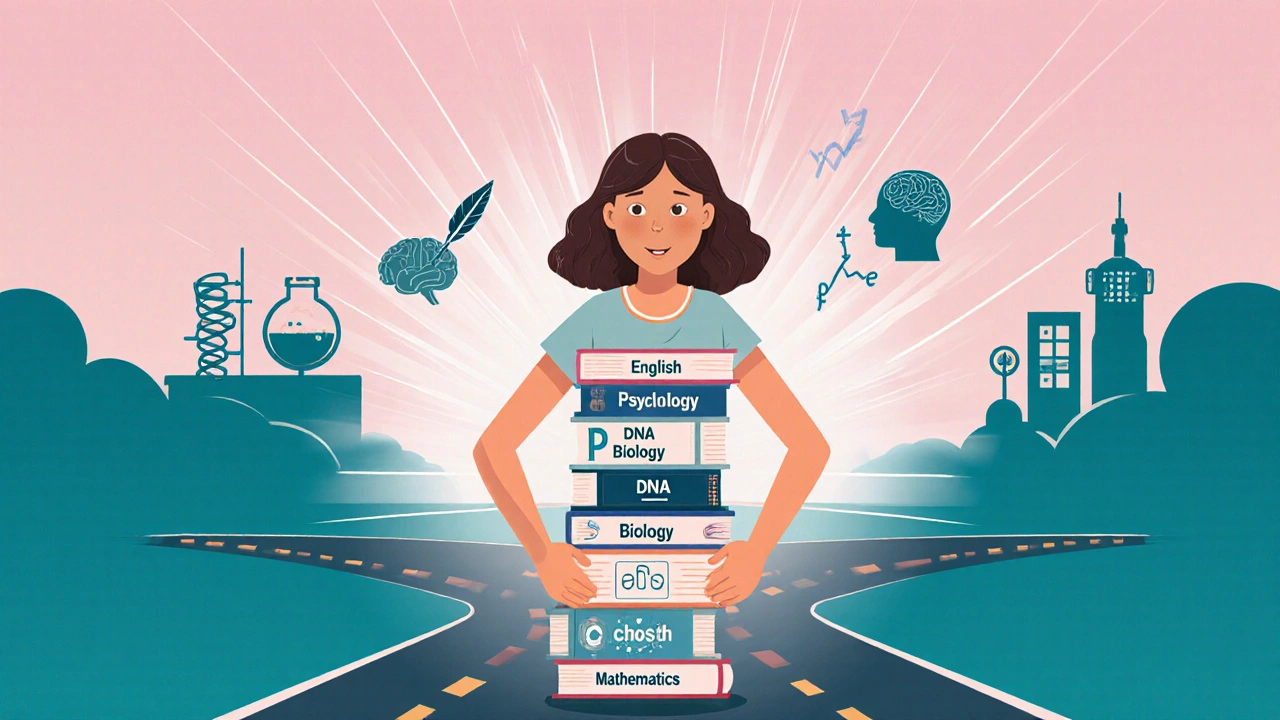A Level Gender Trend Checker
How This Tool Works
Enter the A Level subjects you're considering and see how they compare to the national gender trends for girls in the UK (based on 2023-24 data).
Our data shows English Literature and Psychology as the top choices with 60% and 58% female enrollment respectively.
When you hear the question “What is the most common A Level for girls?”, you’re really asking which subject draws the highest proportion of female students across the UK’s post‑16 system. The answer isn’t a mystery once you look at the latest data from the Department for Education (DfE) and the UCAS enrolment figures for 2023‑24. Below we break down the numbers, explore why certain subjects resonate more with girls, and give practical tips for anyone weighing A Level options.
Key Takeaways
- English Literature and Psychology consistently rank as the two most popular A Level subjects among girls, each attracting roughly 55‑60% female enrollment.
- Biology, Geography and Sociology also show a strong female bias, with women making up 52‑57% of candidates.
- Mathematics and Physics remain the least gender‑balanced, with only about 35‑38% of candidates being female.
- Regional differences are modest; England and Wales mirror the national trend, while Northern Ireland shows a slightly higher uptake of Biology among girls.
- Understanding these trends can help students choose subjects that match both their interests and university aspirations, without feeling boxed into “gender‑typical” choices.
What is an A Level?
A Level is a two‑year qualification studied by students aged 16‑18 in England, Wales and Northern Ireland. It is the traditional route to university and is assessed mainly through final exams, though some subjects incorporate coursework. A Levels are graded from A* to E, and universities typically require three to four A Levels for entry.
Where Do We Get the Gender Data?
The DfE publishes annual subject‑level statistics that break down enrolment by gender. The most recent set covers the 2023‑24 academic year and includes over 250,000 A Level candidates. UCAS also releases subject‑specific application figures, which we cross‑checked to ensure consistency. These sources are considered authoritative because they are compiled directly from school registers and higher‑education admissions data.

Top A Level Subjects Chosen by Girls
Below is a snapshot of the ten subjects with the highest percentage of female candidates. Percentages represent the proportion of women among all students who sat the exam that year.
| Rank | Subject | Female % | Total Candidates |
|---|---|---|---|
| 1 | English Literature | 60% | 45,230 |
| 2 | Psychology | 58% | 28,790 |
| 3 | Biology | 57% | 38,112 |
| 4 | Geography | 55% | 22,470 |
| 5 | Sociology | 54% | 11,340 |
| 6 | History | 53% | 40,880 |
| 7 | Art & Design | 52% | 13,210 |
| 8 | Modern Languages (French, German, Spanish) | 51% | 31,560 |
| 9 | Chemistry | 48% | 34,720 |
| 10 | Mathematics | 38% | 46,900 |
Why Do These Subjects Appeal More to Girls?
Several factors intersect to shape these patterns:
- Curriculum focus. Subjects like English Literature, Psychology and Sociology emphasize narrative, human behaviour and social contexts, which historically align with teaching styles that encourage discussion and empathy-qualities many girls value.
- Career visibility. Biology and Geography open direct pathways to health‑care, environmental science and teaching, fields where women have long established strong representation.
- Role models. Media coverage and school outreach programmes often showcase successful female professionals in medicine, environmental policy and the arts, reinforcing the appeal of related A Levels.
- Assessment style. Coursework‑heavy subjects (e.g., Geography) allow continuous feedback, which can be less intimidating than the high‑stakes exams typical of Physics or Mathematics.
- Parental expectations. Surveys by the National Education Union (NEU) show that parents of girls are more likely to encourage humanities and life science choices, believing they offer broader career options.
Regional Nuances Across the UK
While the overall picture holds nationwide, a few regional quirks emerge:
- In Northern Ireland, Biology sees a slightly higher female share (approx. 60%) thanks to a strong tradition of medical school pipelines.
- Urban schools in London report marginally higher enrolment in Modern Languages among girls, likely reflecting multicultural environments.
- Rural schools in the North East lean a bit more towards Geography, driven by local interest in environmental and agricultural studies.
These differences are modest-within a 5% range-so the national rankings remain a reliable guide for most learners.

How to Use This Information When Choosing A Levels
Knowing the gender trends can help you in three practical ways:
- Confidence building. If you’re drawn to a subject where many girls already excel, you’ll likely find peer support and teaching resources tailored to your perspective.
- Strategic planning. Understanding where the gender gap is widest (e.g., Physics, Mathematics) can inform a decision to diversify your profile, especially if you aim for STEM‑heavy university courses.
- Career alignment. Match subjects to long‑term goals. For health‑related careers, Biology and Chemistry remain top choices; for social‑policy routes, Psychology and Sociology offer a solid foundation.
Tips for Choosing A Levels Beyond Trends
- Follow your curiosity - the subject you’re most interested in will keep you motivated during the demanding exam period.
- Consider university prerequisites - many degree programmes list required or preferred A Levels (e.g., Engineering usually asks for Mathematics and Physics).
- Balance workload - mixing a coursework‑based subject with an exam‑focused one can reduce stress.
- Seek advice from teachers - they can provide insight into how assessment styles match your strengths.
- Don’t let stereotypes dictate you - the data shows trends, not rules. Many successful women excel in traditionally male‑dominated subjects and vice‑versa.
Quick FAQ
Which A Level has the highest percentage of female students?
English Literature tops the list, with about 60% of its candidates being girls in the 2023‑24 cohort.
Why are subjects like Physics still male‑dominant?
Physics relies heavily on abstract problem‑solving and early exposure to advanced maths, areas where historical teaching practices have attracted fewer girls. Efforts are underway to provide more role models and hands‑on labs to close the gap.
Do these trends affect university admissions?
Universities look at grades and subject relevance, not gender composition. However, a balanced subject mix can strengthen an application, especially for interdisciplinary programmes.
Can I choose a subject with low female participation and still succeed?
Absolutely. Success depends on interest, effort and support, not gender ratios. Many women thrive in Maths, Physics and Computer Science and later become leaders in those fields.
Where can I find the raw data for A Level gender statistics?
The Department for Education publishes detailed tables on its website under the “A Level and AS Level statistics” section. UCAS also releases subject‑specific enrolment data each year.
In short, English Literature and Psychology lead as the most common A Level subjects for girls, while Mathematics and Physics lag behind. Use this insight as one piece of the puzzle when planning your A Level journey - combine it with personal passion, university goals and the advice of teachers to make the best choice for your future.

